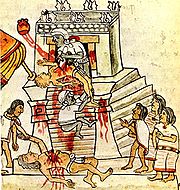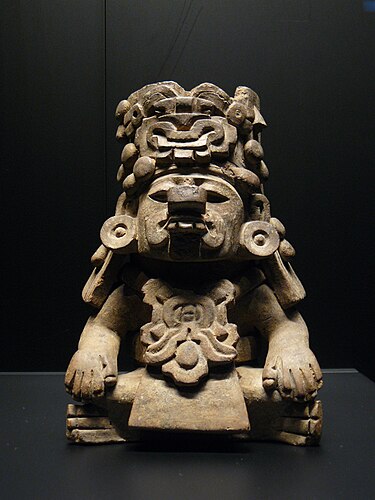Mesoamerica (Spanish: Mesoamérica) is a region and cultural area in the Americas, extending approximately from central Mexico to Belize, Guatemala, El Salvador, Honduras, Nicaragua, and Costa Rica, within which a number of pre-Columbian societies flourished before the Spanish colonization of the Americas in the 15th and 16th centuries.
As a cultural area, Mesoamerica is defined by a mosaic of cultural traits developed and shared by its indigenous cultures. Beginning as early as 7000 BC the domestication of maize, beans, squash and chili, as well as the turkey and dog, caused a transition from paleo-Indian hunter-gatherer tribal grouping to the organization of sedentary agricultural villages. In the subsequent formative period, agriculture and cultural traits such as a complex mythological and religious tradition, a vigesimal numeric system, and a complex calendric system, a tradition of ball playing, and a distinct architectural style, were diffused through the area. Also in this period villages began to become socially stratified and develop into chiefdoms with the development of large ceremonial centers, interconnected by a network of trade routes for the exchange of luxury goods such as obsidian, jade, cacao, cinnabar, Spondylus shells, hematite, and ceramics. While Mesoamerican civilization did know of the wheel and basic metallurgy, neither of these technologies became culturally important.
Among the earliest complex civilizations was the Olmec culture which inhabited the Gulf coast of Mexico. In the Preclassic period, complex urban polities began to develop among the Maya and the Zapotecs. During this period the first true Mesoamerican writing systems were developed in the Epi-Olmec and the Zapotec cultures, and the Mesoamerican writing tradition reached its height in the Classic Maya Hieroglyphic script. Mesoamerica is one of only five regions of the world where writing was independently developed. In Central Mexico, the height of the Classic period saw the ascendancy of the city of Teotihuacan, which formed a military and commercial empire whose political influence stretched south into the Maya area and northward. During the Epi-Classic period the Nahua peoples began moving south into Mesoamerica from the North. During the early post-Classic period Central Mexico was dominated by the Toltec culture, Oaxaca by the Mixtec, and the lowland Maya area had important centers at Chichén Itzá and Mayapán. Towards the end of the post-Classic period the Aztecs of Central Mexico built a tributary empire covering most of central Mesoamerica.
Selected article

Human sacrifice was a religious practice characteristic of pre-Columbian Aztec civilization; the extent of the practice is debated by modern scholars. Spanish explorers, soldiers and clergy who had contact with the Aztecs between 1517, when an expedition from Cuba first explored the Yucatan, and 1521, when Hernan Cortes conquered the Aztec capital of Tenochtitlan, made observations of and wrote reports about the practice of human sacrifice. For example, Bernal Díaz's The Conquest of New Spain includes eyewitness accounts of human sacrifices as well as descriptions of the remains of sacrificial victims. In addition, there are a number of second-hand accounts of human sacrifices written by Spanish friars that relate the testimony of native eyewitnesses. The literary accounts have been supported by archeological research. Since the late 1970s, excavations of the offerings in the Great Pyramid of Tenochtitlan, Teotihuacán's Pyramid of the Moon, and other archaeological sites, have provided physical evidence of human sacrifice among the Mesoamerican peoples.
Human sacrifice among pre-Columbian indigenous populations is a controversial topic. The discussion of human sacrifice is connected with the classic conflict between viewing indigenous peoples as either "noble savages" or "primitive barbarians." Within modern scholarship, some scholars tend to romanticize the description of human sacrifice while others tend to exaggerate it.
Selected biography

Bartolomé de las Casas O.P. (c. 1484 – 18 July 1566) was a 16th-century Spanish historian, social reformer and Dominican friar. He became the first resident Bishop of Chiapas, and the first officially appointed "Protector of the Indians." His extensive writings, the most famous A Short Account of the Destruction of the Indies and Historia de Las Indias, chronicle the first decades of colonization of the West Indies and focus particularly on the atrocities committed by the colonizers against the Indigenous peoples.
Arriving as one of the first settlers in the New World he participated in, and was eventually compelled to oppose, the atrocities committed against the Native Americans by the Spanish colonists. In 1515 he reformed his views, gave up his Indian slaves and encomienda, and advocated, before King Charles V, Holy Roman Emperor, in behalf of rights for the natives. In 1522 he attempted to launch a new kind of peaceful colonialism on the coast of Venezuela, but this venture failed causing Las Casas to enter the Dominican Order and become a friar, leaving the public scene for a decade. He then traveled to Central America undertaking peaceful evangelization among the Maya of Guatemala and participated in debates among the Mexican churchmen about how best to bring the natives to the Christian faith. Traveling back to Spain to recruit more missionaries, he continued lobbying for the abolition of the encomienda, gaining an important victory by the passing of the New Laws in 1542. He was appointed Bishop of Chiapas, but served only for a short time before he was forced to return to Spain because of resistance to the New Laws by the encomenderos, and conflicts with Spanish settlers because of his pro-Indian policies and activist religious stances. The remainder of his life was spent at the Spanish court where he held great influence over Indies-related issues. In 1550 he participated in the Valladolid debate; he argued against Juan Ginés de Sepúlveda that the Indians were fully human and that forcefully subjugating them was unjustifiable. Sepúlveda countered that they were less than human and required Spanish masters in order to become civilized.
Bartolomé de las Casas spent 50 years of his life actively fighting slavery and the violent colonial abuse of indigenous peoples, especially by trying to convince the Spanish court to adopt a more humane policy of colonization. And although he failed to save the indigenous peoples of the Western Indies, his efforts resulted in several improvements in the legal status of the natives, and in an increased colonial focus on the ethics of colonialism. Las Casas is often seen as one of the first advocates for universal Human Rights.
Did you know?
- ... that the Tzeltal people (Tzeltal child pictured) of the Mexican state of Chiapas are descended from the Maya?
- ... that the Central Acropolis of the ancient Maya city of Tikal, built during the Late Preclassic period, served as a residence for Tikal's royal families?
Subcategories
Related portals
Selected image
 |
Cocijo (occasionally spelt Cociyo) is a lightning deity of the pre-Columbian Zapotec civilization of southern Mexico. He has attributes characteristic of similar Mesoamerican deities associated with rain, thunder and lightning, such as Tlaloc of central Mexico. Cocijo was the most important deity among the pre-Columbian Zapotecs because of his association with rainfall.
Featured articles
Good Topics
Good articles
 Gómez de Alvarado
Gómez de Alvarado Aztecs
Aztecs La Blanca, Peten
La Blanca, Peten Calakmul
Calakmul Bartolomé de las Casas
Bartolomé de las Casas Copán
Copán El Chal
El Chal Haʼ Kʼin Xook
Haʼ Kʼin Xook Itzam Kʼan Ahk II
Itzam Kʼan Ahk II Iximche
Iximche Kʼinich Yat Ahk II
Kʼinich Yat Ahk II Kʼinich Yoʼnal Ahk I
Kʼinich Yoʼnal Ahk I Macuahuitl
Macuahuitl Maize
Maize Manche Chʼol
Manche Chʼol Mixco Viejo
Mixco Viejo Motul de San José
Motul de San José Mundo Perdido, Tikal
Mundo Perdido, Tikal North Acropolis, Tikal
North Acropolis, Tikal Potbelly sculpture
Potbelly sculpture William H. Prescott
William H. Prescott Qʼumarkaj
Qʼumarkaj Resplendent quetzal
Resplendent quetzal Seibal
Seibal Serpent labret with articulated tongue
Serpent labret with articulated tongue Spanish conquest of Yucatán
Spanish conquest of Yucatán Spanish conquest of Chiapas
Spanish conquest of Chiapas Spanish conquest of El Salvador
Spanish conquest of El Salvador Spanish conquest of Honduras
Spanish conquest of Honduras Spanish conquest of the Maya
Spanish conquest of the Maya Tikal
Tikal Toniná
Toniná Western Mexico shaft tomb tradition
Western Mexico shaft tomb tradition Benjamin Lee Whorf
Benjamin Lee Whorf Yoʼnal Ahk III
Yoʼnal Ahk III Zaculeu
Zaculeu
Topics
WikiProjects
New articles
Rules | Match log | Results page (for watching) | Last updated: 2024-05-28 21:47 (UTC)
Note: The list display can now be customized by each user. See List display personalization for details.
- Atrial cross (edit | talk | history | links | watch | logs | tools) by Xochiztli (talk · contribs · new pages (2)) started on 2024-05-28, score: 48
- Miss Cosmo International 2024 (edit | talk | history | links | watch | logs | tools) by KamyyFallon (talk · contribs · new pages (1)) started on 2024-05-25, score: 38
- 2024 Mexican Senate election (edit | talk | history | links | watch | logs | tools) by Moscow Mule (talk · contribs · new pages (32)) started on 2024-05-25, score: 54
- Salvadoran campaign of 1832 (edit | talk | history | links | watch | logs | tools) by PizzaKing13 (talk · contribs · new pages (4)) started on 2024-05-25, score: 36
- Third Mexican Provincial Council (edit | talk | history | links | watch | logs | tools) by Moriwen (talk · contribs · new pages (118)) started on 2024-05-24, score: 24
- Juan Martínez Téllez de los Ríos (edit | talk | history | links | watch | logs | tools) by Cesarleonardocruz (talk · contribs · new pages (1)) started on 2024-05-14, score: 24
- Ipomoea setosa (edit | talk | history | links | watch | logs | tools) by WelwitschiaTokarev (talk · contribs · new pages (1)) started on 2024-05-21, score: 56
- Quintonil (edit | talk | history | links | watch | logs | tools) by Tbhotch (talk · contribs · new pages (32)) started on 2024-05-18, score: 36
- List of country subdivision flags in North America (edit | talk | history | links | watch | logs | tools) by For the nth time (talk · contribs · new pages (4)) started on 2024-05-18, score: 26
- Ideoblothrus maya (edit | talk | history | links | watch | logs | tools) by WhatIsAPoggers (talk · contribs · new pages (8)) started on 2024-05-18, score: 40
- List of Michelin starred restaurants in Mexico (edit | talk | history | links | watch | logs | tools) by Expandinglight5 (talk · contribs · new pages (2)) started on 2024-05-17, score: 30
- Chiapanec people (edit | talk | history | links | watch | logs | tools) by Loukus999 (talk · contribs · new pages (9)) started on 2024-05-16, score: 148
- UN Trade and Development (edit | talk | history | links | watch | logs | tools) by Teddyg3892 (talk · contribs · new pages (1)) started on 2024-05-15, score: 24
Associated Wikimedia
The following Wikimedia Foundation sister projects provide more on this subject:
-
Commons
Free media repository -
Wikibooks
Free textbooks and manuals -
Wikidata
Free knowledge base -
Wikinews
Free-content news -
Wikiquote
Collection of quotations -
Wikisource
Free-content library -
Wikiversity
Free learning tools -
Wiktionary
Dictionary and thesaurus
























